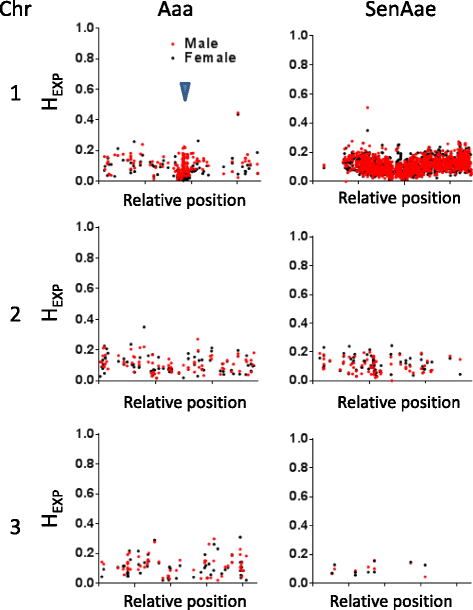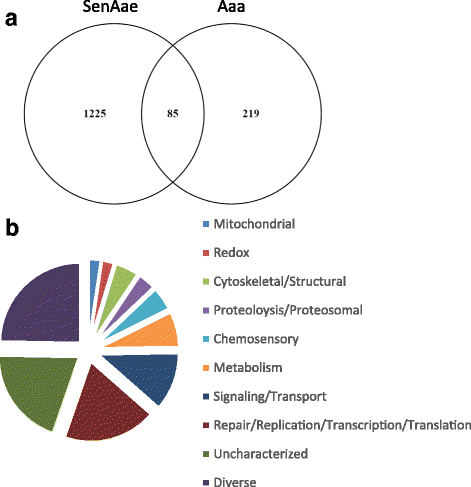Alternative patterns of sex chromosome differentiation in Aedes aegypti (L)
- PMID: 29202694
- PMCID: PMC5716240
- DOI: 10.1186/s12864-017-4348-4
Alternative patterns of sex chromosome differentiation in Aedes aegypti (L)
Abstract
Background: Some populations of West African Aedes aegypti, the dengue and zika vector, are reproductively incompatible; our earlier study showed that divergence and rearrangements of genes on chromosome 1, which bears the sex locus (M), may be involved. We also previously described a proposed cryptic subspecies SenAae (PK10, Senegal) that had many more high inter-sex FST genes on chromosome 1 than did Ae.aegypti aegypti (Aaa, Pai Lom, Thailand). The current work more thoroughly explores the significance of those findings.
Results: Intersex standardized variance (FST) of single nucleotide polymorphisms (SNPs) was characterized from genomic exome capture libraries of both sexes in representative natural populations of Aaa and SenAae. Our goal was to identify SNPs that varied in frequency between males and females, and most were expected to occur on chromosome 1. Use of the assembled AaegL4 reference alleviated the previous problem of unmapped genes. Because the M locus gene nix was not captured and not present in AaegL4, the male-determining locus, per se, was not explored. Sex-associated genes were those with FST values ≥ 0.100 and/or with increased expected heterozygosity (H exp , one-sided T-test, p < 0.05) in males. There were 85 genes common to both collections with high inter-sex FST values; all genes but one were located on chromosome 1. Aaa showed the expected cluster of high inter-sex FST genes proximal to the M locus, whereas SenAae had inter-sex FST genes along the length of chromosome 1. In addition, the Aaa M-locus proximal region showed increased H exp levels in males, whereas SenAae did not. In SenAae, chromosomal rearrangements and subsequent suppressed recombination may have accelerated X-Y differentiation.
Conclusions: The evidence presented here is consistent with differential evolution of proto-Y chromosomes in Aaa and SenAae.
Keywords: Arbovirus vector; Dimorphic traits; Evolution of reproductive proteins; Genomics; Population genetics; Sex determination.
Conflict of interest statement
Ethics approval and consent to participate
Not applicable, because this study does not involve humans, animals or plants. Field permissions were obtained for all collections.
Consent for publication
Not applicable
Competing interests
The authors declare that they have no competing interests.
Publisher’s Note
Springer Nature remains neutral with regard to jurisdictional claims in published maps and institutional affiliations.
Figures



Similar articles
-
Reproductive Incompatibility Involving Senegalese Aedes aegypti (L) Is Associated with Chromosome Rearrangements.PLoS Negl Trop Dis. 2016 Apr 22;10(4):e0004626. doi: 10.1371/journal.pntd.0004626. eCollection 2016 Apr. PLoS Negl Trop Dis. 2016. PMID: 27105225 Free PMC article.
-
Exon-Enriched Libraries Reveal Large Genic Differences Between Aedes aegypti from Senegal, West Africa, and Populations Outside Africa.G3 (Bethesda). 2017 Feb 9;7(2):571-582. doi: 10.1534/g3.116.036053. G3 (Bethesda). 2017. PMID: 28007834 Free PMC article.
-
Extensive Genetic Differentiation between Homomorphic Sex Chromosomes in the Mosquito Vector, Aedes aegypti.Genome Biol Evol. 2017 Sep 1;9(9):2322-2335. doi: 10.1093/gbe/evx171. Genome Biol Evol. 2017. PMID: 28945882 Free PMC article.
-
The sequence of a male-specific genome region containing the sex determination switch in Aedes aegypti.Parasit Vectors. 2018 Oct 20;11(1):549. doi: 10.1186/s13071-018-3090-3. Parasit Vectors. 2018. PMID: 30342535 Free PMC article.
-
Methods for identifying and interpreting sex-linked SNP markers and carrying out sex assignment: application to thornback ray (Raja clavata).Mol Ecol Resour. 2020 Nov;20(6):1610-1619. doi: 10.1111/1755-0998.13225. Epub 2020 Jul 30. Mol Ecol Resour. 2020. PMID: 32657500 Review.
Cited by
-
Aedes aegypti miRNA-33 modulates permethrin induced toxicity by regulating VGSC transcripts.Sci Rep. 2021 Mar 31;11(1):7301. doi: 10.1038/s41598-021-86665-6. Sci Rep. 2021. PMID: 33790374 Free PMC article.
-
Vgsc-interacting proteins are genetically associated with pyrethroid resistance in Aedes aegypti.PLoS One. 2019 Jan 29;14(1):e0211497. doi: 10.1371/journal.pone.0211497. eCollection 2019. PLoS One. 2019. PMID: 30695054 Free PMC article.
-
Introgression of the Aedes aegypti Red-Eye Genetic Sexing Strains Into Different Genomic Backgrounds for Sterile Insect Technique Applications.Front Bioeng Biotechnol. 2022 Feb 2;10:821428. doi: 10.3389/fbioe.2022.821428. eCollection 2022. Front Bioeng Biotechnol. 2022. PMID: 35186905 Free PMC article.
-
In Silico Characterisation of the Aedes aegypti Gustatory Receptors.Int J Mol Sci. 2023 Jul 31;24(15):12263. doi: 10.3390/ijms241512263. Int J Mol Sci. 2023. PMID: 37569638 Free PMC article.
-
Combining two genetic sexing strains allows sorting of non-transgenic males for Aedes genetic control.Commun Biol. 2023 Jun 16;6(1):646. doi: 10.1038/s42003-023-05030-7. Commun Biol. 2023. PMID: 37328568 Free PMC article.
References
-
- Brown JE, McBride CS, Johnson P, Ritchie S, Paupy C, Bossin H, Lutomiah J, Fernandez-Salas I, Ponlawat A, Cornel AJ, Black WC, IV, Gorrochotegui-Escalante N, Urdaneta-Marquez L, Sylla M, Slotman M, Murray KO, Walker C, Powell JR. Worldwide patterns of genetic differentiation imply multiple ‘domestications’ of Aedes aegypti, a major vector of human diseases. Proc Biol Sci. 2011;278(1717):2446–2454. doi: 10.1098/rspb.2010.2469. - DOI - PMC - PubMed
-
- McClelland GAH. A worldwide survey of variation in scale pattern of the abdominal tergum of Aedea aegypti (L.) (Diptera:Culicidae) Trans Royal Entomol Soc Lond. 1974;126:239–259. doi: 10.1111/j.1365-2311.1974.tb00853.x. - DOI
MeSH terms
Grants and funding
LinkOut - more resources
Full Text Sources
Other Literature Sources
Miscellaneous

